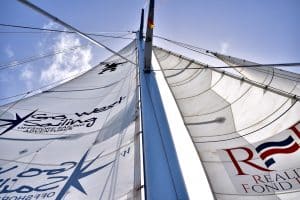We pass our first iceberg about 40 miles from the South Shetland Isles – arching alongside us, sparkling shades of blue in the early evening light and glowing turquoise beneath the calm surface of the grey sea. This was our sixth day at sea; the day before, shortly after midnight, we had crossed the sixtieth parallel south into Antarctica.
We’re aboard the 70 foot Global Surveyor, a rugged steel-built expedition yacht, nine passengers with varying sailing experience, on the most daring sailing adventure of our lives. The unspoken trepidation felt on leaving the safe harbour of Ushuaia, at the southern tip of Patagonia, has quickly faded under the professional crew’s deft and experienced handling of the boat through the ferocious waves of the 800km Drake Passage between South America and Antarctica.
The promise is of a truly authentic, one-in-a-lifetime adventure – a personal Antarctic tour, combined with real sailing experience. On a voyage like this, we all have a role to play and under the ever-watchful eye of lead skipper Danny Drahos, we’ve slipped comfortably into a melodic rhythm – eat, sleep, watch, repeat. An excited shout alerting us to the ice has us all scrambling on to deck, fumbling gloves and cameras, as we see – for most of us, at least – our first iceberg.
It’s heart-stopping and exhilarating – our first glimpse at what’s to come on our journey into the Antarctic unknown. 30 to 40 metres in size, the iceberg is a glittering blue honeycomb of delicate curves and pockmarks. A belt of small ice fragments skirts alongside. To our delight, we see a group of penguins on the ice! It’s agreed; this is a sight and a feeling never to be forgotten.
As midnight approaches, we have our first sight of land. We’re discovering that at this high latitude, nights are short, and it never gets truly dark; cloud-wrapped outlines of the South Shetland Isles form and harden on the horizon. As we draw closer, visibility reduces until we feel the snow in our faces. We’re just 65nm (nautical miles) from the Antarctic Peninsula, the northernmost and most hospitable part of mainland Antarctica.
There’s an electric excitement between us now; visiting this vast, wild continent has been an ambition for so long. We’re adventurers, following in the footsteps of courageous polar explorers – Shackleton, Amundsen, Scott – and we’re ready to discover this beautiful, extreme world for ourselves.
Antarctica is the fifth largest continent, and the coldest; we’re visiting during the summer, when temperatures can range from +10°C to -40°C. There’s no permanent human habitation here, but almost 70 scientific stations, operated by 26 countries, all respecting the Antarctic Treaty. This same Treaty means that visitors to Antarctica must first apply for a permit, only granted to those demonstrating adherence to the strict environmental protocols to respect and protect Antarctica’s coastal areas and wildlife.
Our permit has been organised by Go West Sailing, a respected west-coast Scotland sailing school and the owner-operators of Global Surveyor. The managing director is none other than our skipper Danny, a highly trained RYA/MCA Yachtmaster. As he entertains us with tales of his adventures, we learn that he has sailed to both ends of the world, and, it seems, most places in between. Along with our first mate/engineer Simon and navigator Petr, Danny is a constant reassuring presence during our expedition.
Our first anchorage is outside the abandoned Czech polar station Eco Nelson. We take the dingy ashore to explore the collection of stone and wooden buildings, awed by the glacier beside them. Amongst our group are two Czech scientists; their goal is to collect endemic and rare flora so they head off, eager to search for plant samples.
Our next stop is Bellingshausen, the Russian station on King George Island. We radio ahead and we’re met on the shore by some curious penguins and one of the Russian team. He’s been at the station for ten months, and tells us about the station, their work, and what it’s like to live in polar conditions. We’re introduced to two Orthodox monks; incredibly, they have a small church here. They invite us to look around, describing how the church was originally built in Russia, then dismantled and shipped piece-by-piece to be rebuilt here. They say mass for us and bless our Antarctic journey. We’re honoured when they invite us up to the bell tower, where one of them plays about eight bells for us, by hand. It’s a surprisingly emotional experience.
We spend our days – and sometimes the bright nights – exploring the archipelago. On Half Moon Island we find a colony of chinstrap penguins, Weddell and Antarctic fur seals, then a huge sea lion on the rocky shore. At the abandoned Whalers Bay settlement, the smoke rising through the water reminds us that we’re in an active volcanic area. While we explore, our scientists, Mirek and Petr, continue their search, returning triumphantly.
Early one morning we arrive to Enterprise Island, and Danny skilfully executes a technical move to bring us stern first over the partially submerged wreck of the Governoren whaling factory ship, to tie alongside her bow. It’s low tide, and we can clamber over to see the old whale oil barrels, whaling equipment, and giant engines. The story of her wreckage is both tragic and courageous – in 1915, during crew celebrations at the end of a successful season, she caught fire. As the highly flammable whale oil caught alight, the captain bravely drove the burning boat ashore, saving all aboard.
Half a day’s sailing away, our next trip ashore is to the Chilean Gabriel González Videla station. After the warmest of welcomes from the team, we visit their small museum before exploring. Here, amongst the thousands of Gentoo penguins, we spot albino penguins – their light cream bodies standing out in a sea of black and white.
When the weather turns, we anchor off the mainland to wait out the strongest winds and wildest waves, carefully maintaining anchor patrols to watch for ice. Despite the conditions, we’re confident in our crew and in the Global Surveyor. Aptly described as the ‘ultimate machine’, she was designed and built by master mariner and marine engineer Graham Lascelles and naval architects Gunter Marine in 1998 for round the world sailing.
Extensively refitted by Go West Sailing in 2020, it’s hard not to be impressed. She’s intentionally over-specced, designed for voyaging to any ocean, from the tropics to the edge of pack ice. Her seven watertight compartments and crash bulkheads are unheard of in a boat of her size, and she has an extra-thick hull and over-sized cutter rig for sail management. There’s an extensive safety kit, including ocean-class life rafts and satellite communication.
We see some Antarctic cruise ships on our journey, but delight in slipping away to explore the places they can’t reach – the undisturbed wilds and remoteness is an essential part of the magic here. Indeed, away from the constant distractions of everyday life, we feel more attuned to our senses and these vast, powerful landscapes.
Heading further south, we’re on constant watch as icebergs speed around like trains, the current and wind assisting them. Soon we’re all on deck, spellbound as penguins dive from their floating homes; whales dance and parade so close to us that we could almost touch them, leaving us awed and elated.
Our final stop is Port Lockroy, a natural harbour on Goudier Island, home to Britain’s first Antarctic base and the birthplace of the British Antarctic Survey. Today, the base is operated as historic site and living museum; we’re transported back to 1962, and it truly feels like the station’s team have just stepped out for a moment. Among the services for visitors is use of the post office, and some of us send souvenir postcards home, knowing that we’ll still beat them back.
When we reluctantly turn northwards, the Argentine Islands slide by, kaleidoscopes of rocks and ice, light and shadow. Low clouds frame the horizon, sunlit peaks occasionally piercing through. The days grow warmer and the nights darker as we cross a quietened Drake Passage. Our arrival back to Ushuaia feels triumphant under bright blue skies – together we sailed 1,577 nautical miles, on truly a journey of a lifetime.
To find out more about Antarctic sailing adventures with Go West Sailing, visit gowestsailing.com/antarctica. Trips depart from and return Ushuaia, with a 21-day itinerary.















 From souther Itajai to Salvador via Rio de Janeiro
From souther Itajai to Salvador via Rio de Janeiro
